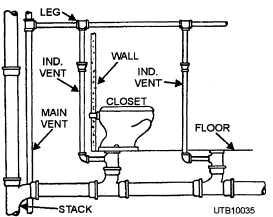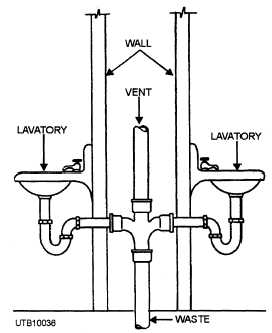of nickel or chrome-plated brass, malleable galvanized; cast iron, other metal alloys, and plastic.
The P-trap is used for fixtures suspended from the walls or supported on pedestals, for instance, lavatories, sinks, and urinals. At times the P-trap may also be suitable in showers, baths, and installations that do not waste large amounts of water.
When using a P-trap for fixtures suspended from the wall, you should install it as close to the fixture as possible. Be careful not to install a vertical leg that is too long between the trap and the fixture. It is also important for the horizontal leg connection to the waste system to be short for ventilation purposes.
VENTS
To prevent the siphonage of a trap seal in fixture traps and allow gravity flow of drainage, you must let atmospheric air from outside the building into the piping system to the outlet (or discharge) end of the trap. The air is supplied through pipes called VENTS. This air provides pressure on the outlet end of the seal equal to pressure on the inlet end.
Atmospheric pressure at sea level is about 14.7 pounds per square inch. This pressure remains virtually constant on the inlet end of the water seal. Obviously, a greater or lesser amount of pressure on the outlet end of the trap seal forces the water in the direction of least resistance. Since the air supplied by the vent to the outlet end provides a pressure equal to that at the inlet end of the trap, the trap seal cannot escape through siphonage.
All vent systems should be provided with a main vent or vent stack and a main soil and waste vent. A "main vent" may be defined as the principal artery of the venting system, and vent branches may be connected to the main vent and run undiminished in size as directly as possible from the building drain to the open air above the roof. The MAIN SOIL AND WASTE STACK, as shown in figure 3-8, is installed in a vertical position.
The term main soil and waste vent, or soil stack vent, refers to the portion of the stack extending above the highest fixture branch. In figure 3-8, this vent extends through the roof. Actually, it is an extension of the main soil and waste stack.
Common Types of Vents
Various types of vents are used in the ventilation of fixtures; even in the best of installations, you may find several different types of vents. The selection of a particular type of vent depends largely on the manner in which the plumbing fixtures are located and grouped. Some of the common types of vents you may use frequently in your work are mentioned briefly below. An INDIVIDUAL VENT, also known as a BACK VENT, is a vent that connects the main vent with the individual trap underneath or behind a fixture. This method of venting is shown in figure 3-35. When you install two or more fixtures on an individual vent basis, ensure the leg (see illustration) connecting individual vents to the main vent is large enough to carry the total load.
A COMMON VENT vents two traps to a single vent pipe, as shown in figure 3-36. The unit vent can be used when a pair of lavatories are installed side by side, as well as when they are hung back to back on

Figure 3-35. - Individual (or back) venting.

Figure 3-36. - Two fixtures unit vented.
Continue Reading